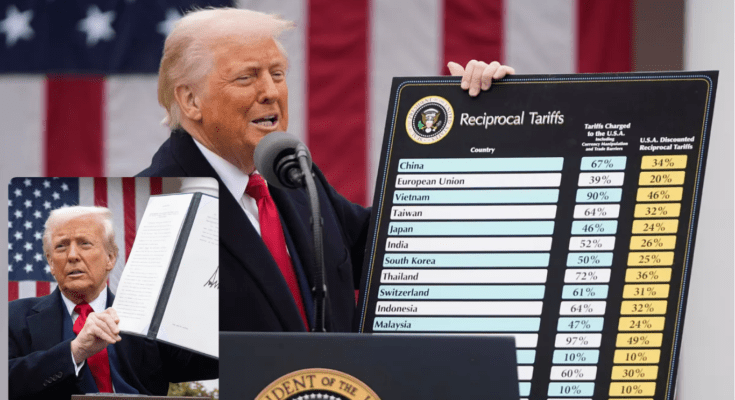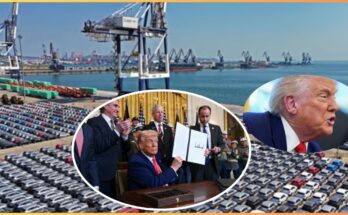Former President Donald Trump has once again made headlines by imposing massive reciprocal tariffs on foreign goods. This bold move is shaking up global trade, sparking debates, and leaving many Americans wondering—what does this mean for the economy, businesses, and everyday consumers?
In this article, we’ll break down Trump’s latest tariff strategy, why he’s doing it, and how it could impact prices, jobs, and international relations. Whether you support his policies or not, understanding these tariffs is crucial because they could affect your wallet.
What Are Reciprocal Tariffs?
Before diving into Trump’s latest move, let’s clarify what reciprocal tariffs actually mean.
- Tariffs are taxes on imported goods.
- Reciprocal tariffs mean if another country charges the U.S. a certain tax on American products, the U.S. will charge them the same rate in return.
Trump has long argued that many countries take advantage of the U.S. by imposing higher tariffs on American goods than the U.S. does on theirs. His solution? Fight back with equal or higher tariffs.
Why Trump Believes in Reciprocal Tariffs
- Level the Playing Field: Some countries tax U.S. exports at much higher rates than the U.S. taxes their imports.
- Protect American Jobs: By making foreign goods more expensive, Trump hopes companies will bring manufacturing back to the U.S.
- Reduce Trade Deficits: The U.S. imports more than it exports with some nations. Tariffs could force better trade deals.
Critics, however, warn that tariffs can backfire, leading to higher prices and trade wars.
Trump’s Latest Tariff Move: A “Jolt” to Global Trade
Trump recently announced aggressive new tariffs targeting multiple countries. While exact details are still emerging, reports suggest these could be some of the highest trade penalties seen in years.
Which Countries Are Affected?
While Trump hasn’t released a full list, past policies suggest likely targets include:
- China (already faced heavy tariffs during his presidency)
- European Union (especially on cars and steel)
- Mexico & Canada (despite the USMCA trade deal)
- Other major exporters to the U.S.
What Products Could Get More Expensive?
If foreign goods face higher tariffs, Americans might see price hikes on:
- Electronics (phones, TVs, computers)
- Cars (especially European & Asian brands)
- Clothing & Shoes (many are imported)
- Steel & Aluminum (could raise construction costs)
The Pros: Why Some Support Trump’s Tariffs
1. More U.S. Manufacturing Jobs
Trump argues that if foreign goods become pricier, companies will move production back to America, creating jobs.
2. Stronger Trade Deals
By playing hardball, Trump believes other countries will lower their tariffs on U.S. goods to avoid penalties.
3. National Security Boost
Some industries, like steel and tech, are seen as vital for national security. Tariffs could reduce reliance on foreign suppliers.
The Cons: Risks & Criticisms
1. Higher Prices for Americans
Tariffs often lead to inflation. If imported goods cost more, companies may pass those costs to consumers.
2. Retaliation from Other Countries
If the U.S. slaps tariffs on them, they might do the same—hurting American farmers and exporters.
3. Possible Job Losses in Some Sectors
Industries relying on imports (like retail) could suffer, leading to layoffs or store closures.
How This Could Impact the 2024 Election
Trump’s tariff policy is already a major campaign issue. Here’s how it might play out:
- Supporters see it as tough leadership putting America first.
- Opponents warn it could hurt the economy and increase living costs.
If prices rise sharply before the election, it could sway voters.
What’s Next? Possible Outcomes
1. Short-Term Price Hikes
Consumers may feel the pinch first, especially on big-ticket items.
2. Long-Term Shifts in Trade
If tariffs stay, some companies might relocate factories to the U.S.—but that takes years.
3. New Trade Wars?
If other countries retaliate, global trade could slow down, affecting economies worldwide.
Final Thoughts: A High-Stakes Gamble
Trump’s latest tariff push is a high-risk, high-reward strategy. If it works, it could revive U.S. manufacturing and force fairer trade deals. If it backfires, it might lead to higher costs, job losses, and economic tension.
For now, businesses and consumers should prepare for possible price increases and stay informed as this trade battle unfolds.
Key Takeaways
✔ Reciprocal tariffs mean the U.S. matches other countries’ import taxes.
✔ Trump’s goal: Protect U.S. jobs, reduce trade deficits, and boost manufacturing.
✔ Risks: Higher consumer prices, trade wars, and economic uncertainty.
✔ This could be a major issue in the 2024 election.
What do you think? Are Trump’s tariffs a smart move or a dangerous gamble? Let us know in the comments!
Keywords for SEO: Donald Trump tariffs, reciprocal tariffs, U.S. trade policy, Trump trade war, import taxes, U.S. manufacturing jobs, global trade impact, 2024 election issues.




